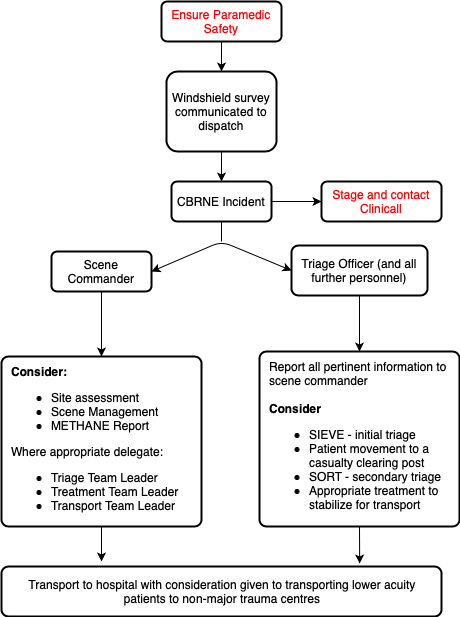Confirmation
A05: Mass Casualty Incidents
Introduction
A mass casualty incident, or multi-casualty incident (MCI), exists when the initial response becomes overwhelmed. This occurs when the number of casualties exceeds the capacity of the initial resources, preventing effective management and conveyance. The successful management of a MCI requires the effective use of resources to create a balance between the available supply of responders, equipment, and assets to that of the MCI.
Experience has shown that in the event of a MCI, patient care is optimized if crews follow a pre-arranged plan. Scene management should include consideration of various factors including safety, site assessment, liaison, command, communications, triage, treatment, and conveyance.
Where practical, the first unit on scene should adopt the command and triage responsibilities while also ensuring pertinent information is provided to the dispatch centre and that appropriate resources are distributed as required. The initial scene commander and triage officer are responsible for their tasks until relieved by senior clinicians or supervisors.
The responsibilities for the first arriving crew can be divided as follows:
- Driver: The scene commander in urban and metro environments provides an initial windscreen situation report and collects information necessary for the METHANE report. The scene commander is the contact between the scene and the communication centre.

The Prometheus IMT app can help with developing a METHANE report: iOS | Android
- Attendant: The triage officer uses the 'Sieve Triage Process' to facilitate the prioritization of treatment and patient movement from the incident area to the casualty clearing post. A count of patients and their triage priorities are reported back to the scene commander.

During the Sieve Triage Process, a tag is provided to each patient with the relevant priority colour. Patients are then moved from the incident area to the casualty clearing post where patients are assigned to various areas according to their triage priority.
At the casualty clearing post, a secondary triage assessment will reassess the casualty’s priority status. This is referred to as the ‘Sort Triage Process’ and assesses the patient's GCS, respiratory rate, and systolic blood pressure to arrive at a score corresponding to a priority level. Conveyance can begin once enough resources are on scene to manage casualties. Patients are then conveyed from the scene ensuring the right patient is conveyed using the right clinical pathway in the right time frame.
